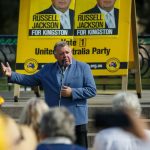What does the 2018 budget mean for society?

“What have you achieved? What are you going to do now? What does it mean for me? These are the questions Australians want answered tonight. So, let me get to it.” said Treasurer Scott Morrison in his 2018 Budget speech on 8 May.
“What does it mean for me?” We’ve also seen this question in countless media headlines reporting on the budget. For households who are struggling to meet living expenses, this is an important question.
But while we’re encouraged to consider what it means to us personally, we’re distracted from asking bigger questions: What does it mean for society? Is this budget creating the Australia we want?
The budget has gone some way in recognising that further support is needed; for our people who are aged, for people with disabilities, and for assistance to manage the costs of electricity/gas; but it has not delivered on responding to climate change, broader responsibilities to aid in our region, for refugees or migrants.
The 2018 Budget has not delivered for our most marginalised our most disadvantaged groups: the 1 in 200 people who are homeless on any given night, the almost 3 million people living in poverty, including 731,000 children, the almost 1 in 3 people who are in part-time or precarious employment, or the more than 1.3m people who are either unemployed/ employed and fighting for not enough job vacancies.
In short, the 2018 Budget has not delivered for Australian society.
The budget didn’t deliver for people in precarious employment situations. We know that almost one-third of people living in poverty in Australia are engaged in employment and report their main source of income is wages or salary.
We have increasing numbers of people working part-time (31% of workers) and in casual or unstable contractual jobs. This group are significantly more at risk of experiencing severe or high financial stress.
For people who do not have a job, the 2018 budget responded with measures to keep ‘welfare spending under control’ and to ‘crack down on behalf of tax paying Australians’ through cashless welfare cards, enhanced debt collection activities, and longer waiting times for new migrants, rather than an increase to the Newstart allowance.
This was despite shared support from across business and social sectors to #raisetherate which currently is below the poverty line and makes it difficult for people to have sufficient resources for housing, food and the expenses that come with looking for a job.
We have seen increases in the number of people employed and increases in the number of jobs available, but this seemingly good news is tempered by the fact that we still have a situation where there are only enough job vacancies for fewer then 1 in 10 unemployed or underemployed job seekers.
Speaking of young people, there are some notable changes in education beyond what was announced in the 2017 budget. Most controversial is the $247 million over four years for the National School Chaplaincy Program which will have a new focus on anti-bullying.
A further $440 million will be dedicated to preschool education in 2019, extending the National Partnership Agreement on universal access to early childhood education for another year.
There are some increased investments in medical research, but the news isn’t good for the vocational education and training (VET) sector which got no additional funding or initiatives, despite our young people still facing unemployment rates at over twice that of the general populations (12.5% compared to 5.5%).
Students living in regional, rural and remote communities will have improved support to access further education, training and employment, along with specific Commonwealth Support Places being created for students commencing a Bachelor’s degree through a Regional Study Hub university.
The budget also left out housing affordability, beyond references to previous budget measures on the ‘supply of affordable housing’ through the National Housing Finance and Investment Corporation and some new releases of Commonwealth land.
It did not address homelessness, even though we’ve seen an increase in the number (14% growth) and proportion (5%) of people who are homeless on any given night between the 2011 and 2016 Census. It did not address the waitlists for social housing (194,600 households). And the now-infamous $10/ week saving will not be sufficient to change the affordability of housing.
The gaps are large. For example, the proportion of households in housing stress has significantly increased (from 14.1% to 17.4% between 2001 and 2016) and while we saw median annual rent and mortgage repayments more than double (2001-2016), median household income only increased by 83%.
One area that is encouraging, is that the budget has alleviated some concern over the NDIS, with the Treasurer stating it would continue to be fully funded. However, the change in funding source, from Medicare levy to tax revenue, has generated concern within the community.
Importantly for the implementation of the NDIS, the budget does not address the current cap on the number on government employees which has led to an under resourcing of the implementation agency – the National Disability Insurance Agency. Key marginalised groups also continue to miss out on the NDIS, including people in prison.
Mental health is an area which is also receiving additional investment. The Budget provides $338.1 million in new mental health funding, with a focus on suicide prevention, research and older Australians, as well as advancing the Fifth National Mental Health and Suicide Prevention Plan.
A new report released by Mental Health Australia demonstrates the clear economic case for investing in the mental health and wellbeing of Australians, so it’s important that the funding in the Budget is built upon going forward, given the years of under-investment we’ve seen.
There’s also positive news for impact investing. Building on $30 million of commitments in last year’s Budget, the Government will provide a further $8.3 million to support the growth of impact investing. $6.7 million of this will be directed towards building capacity in impact measurement, including through the development of an impact framework aligning with the ‘Australian Government principles for social impact investing’.
This aligns well with the work CSI has been doing in this space through initiatives like Amplify Social Impact, the Social Enterprise Reporting Tool and the Social Enterprise Impact Lab.
Investing in infrastructure to support social impact investment could potentially result in untapping more capital to address complex social issues (next week, with AHURI, we release our latest report into social impact investing as a potential avenue to address housing supply and homelessness).
It’s not the just the commitment of dollars that matters, but the symbolic significance of the Australian Government’s recognition of the role impact investing plays in addressing our nation’s social and environmental challenges.
Overall, if we go back to Scott Morrison’s question “What does it mean for me?” and reframe it as “What does it mean for a better society?”, at the Centre for Social Impact, we do not believe that the 2018 Budget does enough to address key complex social issues or to support people who are most disadvantaged.
We know we’re not alone in our disappointment. Given the response on social media and the trending #keepmytendollars hashtag, it may be that the government is out of touch with a growing number of Australians who are asking the question: “What does the budget mean for a better world?”.
Professor Kristy Muir is the CEO of the Centre for Social Impact and a Professor of Social Policy at UNSW Sydney. She has worked for more than two decades with for-purpose organisations to help understand, measure, and find innovative solutions to complex social problems.











